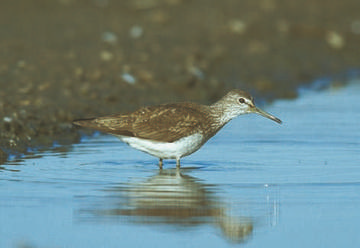Green Sandpiper (Tringa ochropus)

Green Sandpiper © Andy Harmer
The status assessment for this elusive species, published annually in Cheshire and Wirral Bird Reports, is ‘scarce autumn migrant, rare in winter and spring’, meaning an average of 1 to 5 birds each winter, so it was a surprise that Green Sandpipers were recorded in 50 tetrads during the three winters of this Atlas. The map shows them to have been scattered widely across the county, but not in east Cheshire or Wirral beyond Inner Marsh Farm (SJ37B). During the BTO Winter Atlas (1981/ 82 to 1983/ 84) birds were found in all three 10 km squares SJ96, SJ97 and SJ98, but now they seem to be confined to the lowlands. There were at least 31 birds in 2004/ 05, 22 birds in 2005/ 06 and 19 birds in 2006/ 07. Most occurred on their own, but seven tetrads had two, one held three birds and five were counted at Mere Farm Quarry (SJ87H) on 20 November 2005 when smaller waters were iced over in a cold spell.
All of the Green Sandpiper’s habitats are damp, with 41 of the 60 submitted codes being category G – freshwater – but they especially make use of small wet areas. One quarter of the total (15) were narrow watercourses – streams or ditches – with a further four on small ponds. All other types of freshwater habitat were represented, but there was only one record from a canal, showing a clear differentiation in winter habitat between this species and Common Sandpiper. A further seven records were in C6 (water-meadows) or C7 (reed-swamp), and nine in agricultural grassland (E1 or E2) including flooded areas and seasonal flashes.
Their main food is aquatic invertebrates, mostly from near the surface, Green Sandpipers rarely probing into the ground. Birds at a Hertfordshire site were actively feeding 80% of the time in daylight, and flew to roost at a gravel pit 3.2 km away. They foraged for food from 16% to 40% of the time at night, increasing according to how cold it was (Smith et al 1999).
Perhaps half a million pairs breed in eastern Europe, most of them in Finland and Russia, wintering mainly in southern Europe and Africa, many of them crossing the Sahara. There is no definitive evidence of the origins of British wintering birds, but they are likely to be from the northern parts of their breeding range (Migration Atlas).
The national wintering total in the BTO Winter Atlas (1981/ 82 to 1983/ 84) was estimated as 500-1,000 Green Sandpipers annually. This figure is likely to have increased and certainly wintering Green Sandpipers in Cheshire and Wirral have become much more common in the last forty years, as shown by the county annual bird reports. During the 1960s, the maximum appears to have been four birds at three sites, with some winters having no records at all.
Through the 1970s the numbers clearly rise but are impossible to follow because the annual reports jumble the early and late winter periods; by 1978 the report declares that it ‘probably occurs on all our river systems during the winter months’. From 1982/ 83 onwards, quantitative records show presence of an average of 14 birds at 10 sites, fluctuating by a few either side of those figures, a level that seems to have been maintained, probably with a gradual increase, until this Atlas prompted more extensive fieldwork.
Intensive study of marked birds elsewhere shows that an individual may return to the same wintering areas for a number of years, and some Cheshire sites have become ‘regular’ for this species, some clocking up ten or more successive years with a Green Sandpiper present in winter. However, there can also be much movement between sites during the course of the winter, particularly during periods of severe weather, and it is difficult to establish true population levels.
Sponsored by David and Fran Cogger in memory of Tina

